Belkin F5D8231-4 N1 Wireless Router User Manual Table of Contents
Belkin International, Inc. N1 Wireless Router Table of Contents
Belkin >
Contents
- 1. Manual 1
- 2. Manual 2
Manual 2
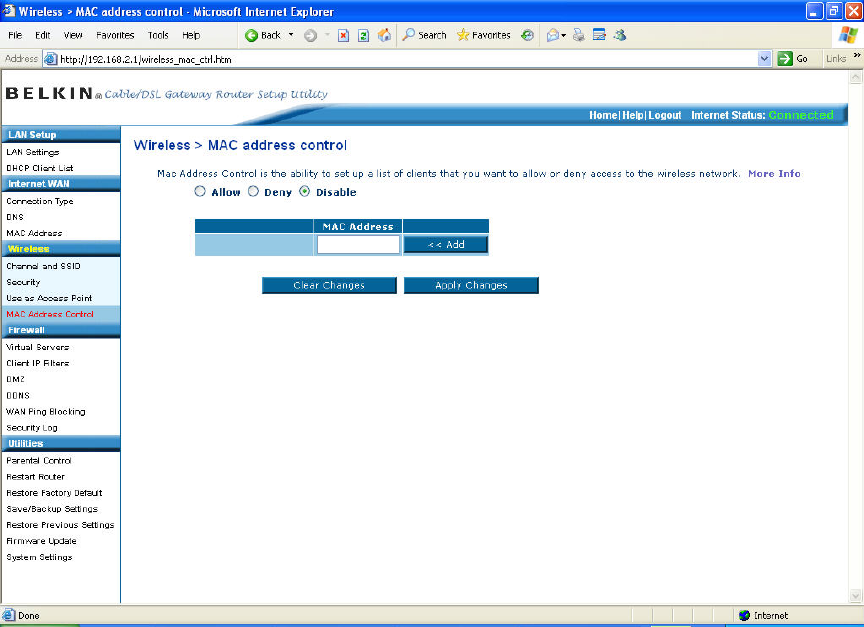
Setting up an Allow Access List
1. Select the “Allow” radio button (1) to begin setting up a list of computers
allowed to connect to the wireless network.
2. Next, in the “MAC Address” field that is blank (3), type in the MAC address of
the wireless computer you want to be able to access the wireless network,
then click “<<Add” (4).
3. Continue to do this until all of the computers you want to add have been
entered.
4. Click “Apply Changes” (5) to finish.
Setting up a Deny Access List
The “Deny Access” list lets you specify computers that you DO NOT want to
access the network. Any computer in the list will not be allowed access to the
wireless network. All others will.
1. Select the “Deny” radio button (2) to begin setting up a list of computers to be
denied access to the wireless network.
2. Next, in the “MAC Address” field that is blank (3), type in the MAC address of
the wireless computer you want to deny access to the wireless network, then
click “<<Add” (4).
N1 Wireless Router.doc Page 51 of 100
N1 Wireless Router.doc Page 52 of 100
3. Continue to do this until all of the computers you want to deny access to have
been entered.
4. Click “Apply Changes” (5) to finish.
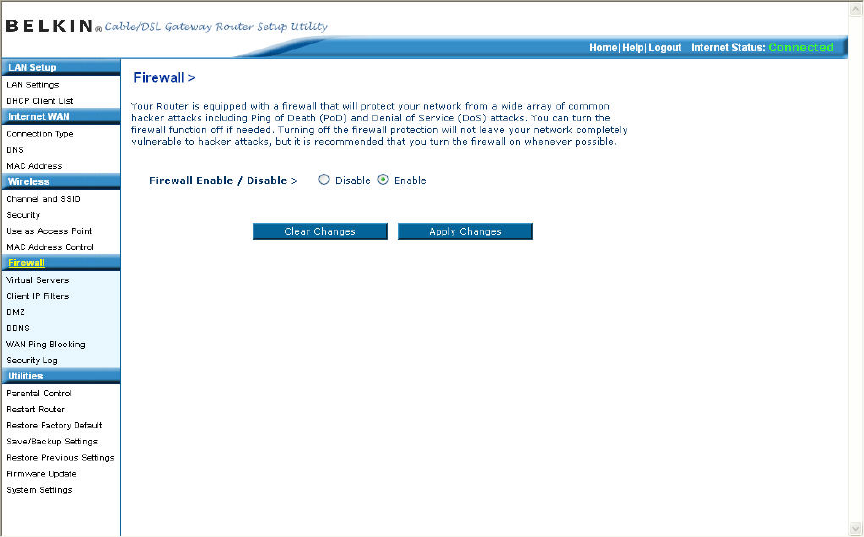
Configuring the Firewall
Your Router is equipped with a firewall that will protect your network from a wide
array of common hacker attacks including:
• IP Spoofing
• Land Attack Ping of Death (PoD)
• Denial of Service (DoS)
• IP with zero length
• Smurf Attack
• TCP Null Scan
• SYN flood
• UDP flooding
• Tear Drop Attack
• ICMP defect
• RIP defect
• Fragment flooding
•
The firewall also masks common ports that are frequently used to attack
networks. These ports appear to be “stealth” meaning that for all intents and
purposes, they do not exist to a would-be hacker. You can turn the firewall
function off if needed; however, it is recommended that you leave the firewall
enabled. Disabling the firewall protection will not leave your network completely
vulnerable to hacker attacks, but it is recommended that you leave the firewall
enabled.
N1 Wireless Router.doc Page 53 of 100
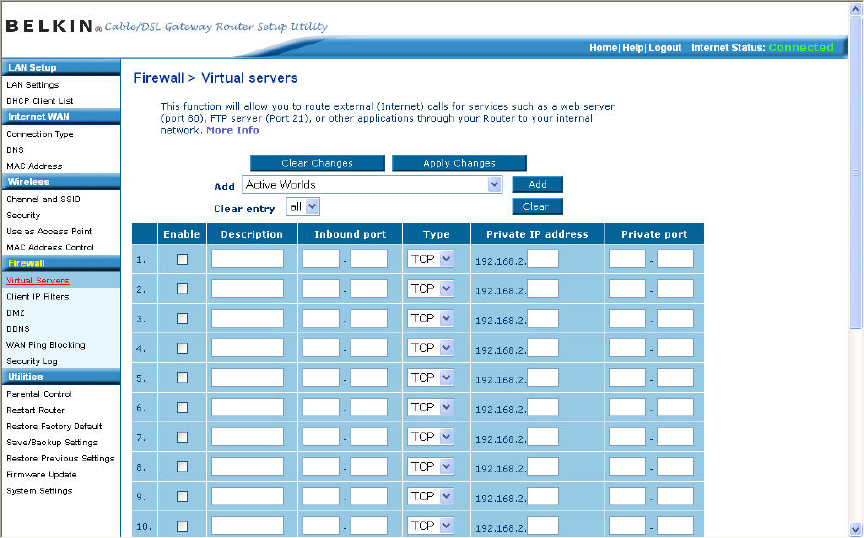
N1 Wireless Router.doc Page 54 of 100
Configuring Internal Forwarding Settings
The Virtual Servers function will allow you to route external (Internet) calls for
services such as a web server (port 80), FTP server (Port 21), or other
applications through your Router to your internal network. Since your internal
computers are protected by a firewall, computers outside your network (over the
Internet) cannot get to them because they cannot be “seen”. A list of common
applications has been provided in case you need to configure the Virtual Server
function for a specific application. If your application is not listed, you will need to
contact the application vendor to find out which port settings you need.
Choosing an Application
Select your application from the drop-down list. Click “Add”. The settings will be
transferred to the next available space in the screen. Click “Apply Changes” to
save the setting for that application. To remove an application, select the number
of the row that you want to remove then click “Clear”.
Manually Entering Settings into the Virtual Server
To manually enter settings, enter the IP address in the space provided for the
internal (server) machine, the port(s) required to pass (use a comma between
multiple ports), select the port type (TCP or UDP), and click “Apply Changes”.
You can only pass one port per internal IP address. Opening ports in your firewall
can pose a security risk. You can enable and disable settings very quickly. It is
recommended that you disable the settings when you are not using a specific
application.
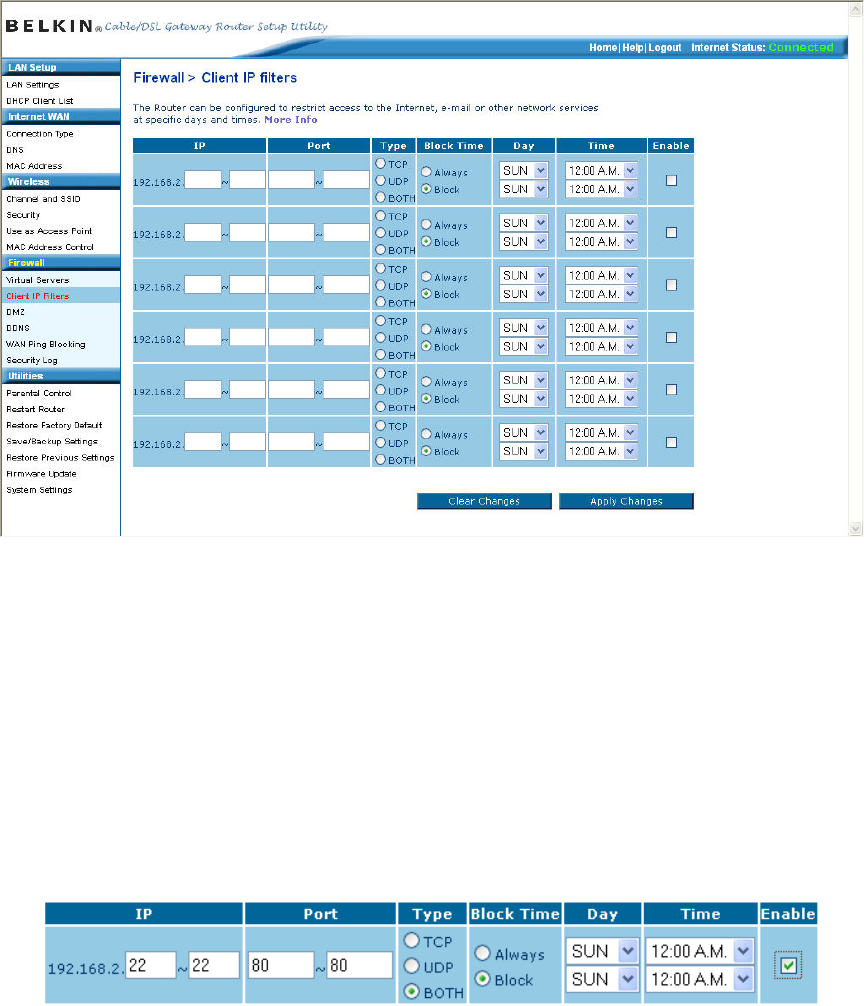
Setting Client IP Filters
The Router can be configured to restrict access to the Internet, e-mail, or other
network services at specific days and times. Restriction can be set for a single
computer, a range of computers, or multiple computers.
To restrict Internet access to a single computer for example, enter the IP address
of the computer you wish to restrict access to in the IP fields (1). Next, enter “80”
in both the port fields (2). Select “Both” (3). Select “Block” (4). You can also
select “Always” to block access all of the time. Select the day to start on top (5),
the time to start on top (6), the day to end on the bottom (7), and the time to stop
(8) on the bottom. Select “Enable” (9). Click “Apply Changes”. The computer at
the IP address you specified will now be blocked from Internet access at the
times you specified. Note: Be sure you have selected the correct time zone
under “Utilities> System Settings> Time Zone”.
N1 Wireless Router.doc Page 55 of 100
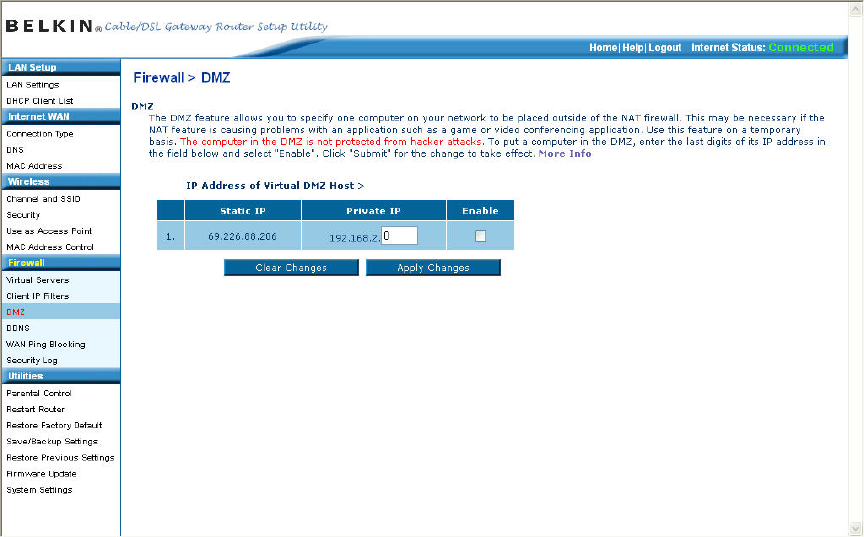
N1 Wireless Router.doc Page 56 of 100
Enabling the Demilitarized Zone (DMZ)
The DMZ feature allows you to specify one computer on your network to be
placed outside of the firewall. This may be necessary if the firewall is causing
problems with an application such as a game or video conferencing application.
Use this feature on a temporary basis. The computer in the DMZ is NOT
protected from hacker attacks.
To put a computer in the DMZ, enter the last digits of its IP address in the IP field
and select “Enable”. Click “Apply Changes” for the change to take effect. If you
are using multiple static WAN IP addresses, it is possible to select which WAN IP
address the DMZ host will be directed to. Type in the WAN IP address you wish
the DMZ host to direct to, enter the last two digits of the IP address of the DMZ
host computer, select “Enable” and click “Apply Changes”.
Using Dynamic DNS
The Dynamic DNS service allows you to alias a dynamic IP address to a static
host name in any of the many domains DynDNS.org offers, allowing your
network computers to be more easily accessed from various locations on the
Internet. DynDNS.org provides this service, for up to five host names, free to the
Internet community.
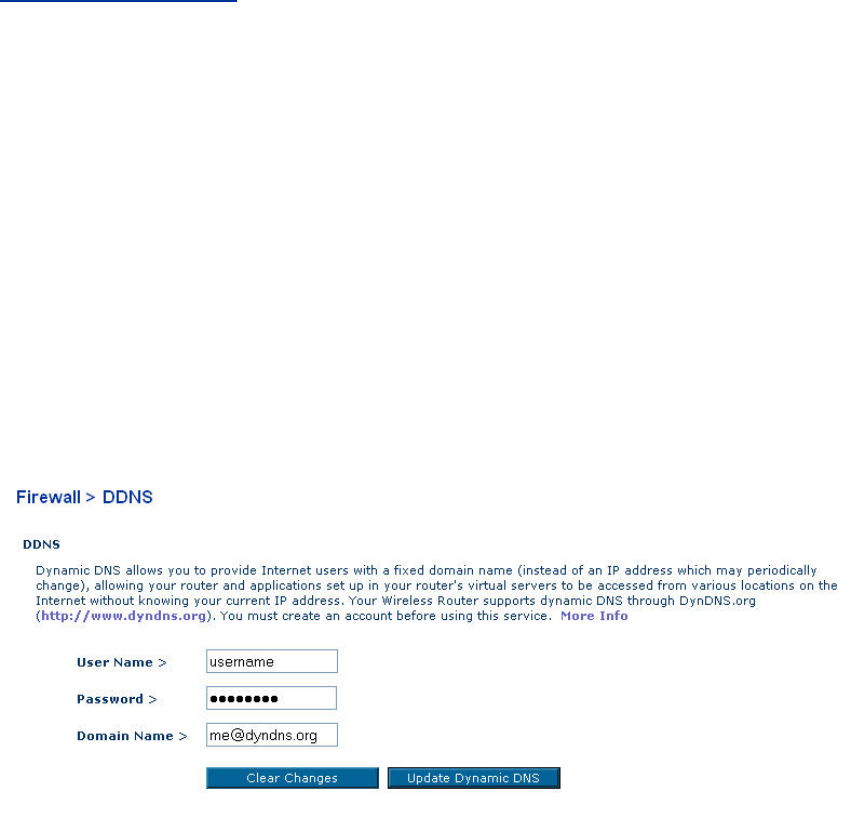
The Dynamic DNSSM service is ideal for a home website, file server, or to make it
easy to access your home PC and stored files while you’re at work. Using the
service can ensure that your host name always points to your IP address, no
matter how often your ISP changes it. When your IP address changes, your
friends and associates can always locate you by visiting yourname.dyndns.org
instead!
To register free for your Dynamic DNS host name, please visit
http://www.dyndns.org.
Setting up the Router’s Dynamic DNS Update Client
You must register with DynDNS.org’s free update service before using this
feature. Once you have your registration, follow the directions below.
1. Enter your DynDNS.org user name in the “User Name” field (1).
2. Enter your DynDNS.org password in the “Password” field (2).
3. Enter the DynDNS.org domain name you set up with DynDNS.org in the
“Domain Name” field (3).
4. Click “Update Dynamic DNS” to update your IP address.
Whenever your IP address assigned by your ISP changes, the Router will
automatically update DynDNS.org’s servers with your new IP address. You can
also do this manually by clicking the “Update Dynamic DNS” button (4).
Blocking an ICMP Ping
Computer hackers use what is known as “pinging” to find potential victims on the
Internet. By pinging a specific IP address and receiving a response from the IP
address, a hacker can determine that something of interest might be there. The
N1 Wireless Router.doc Page 57 of 100
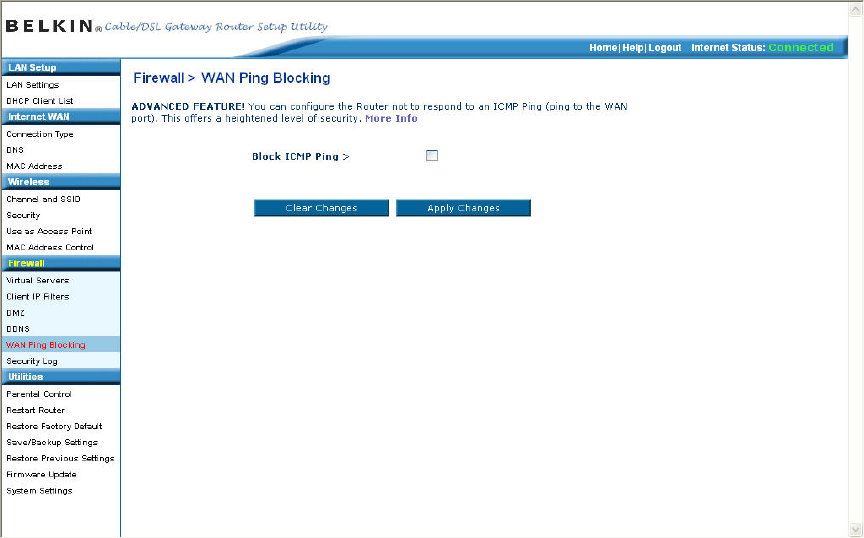
N1 Wireless Router.doc Page 58 of 100
Router can be set up so it will not respond to an ICMP ping from the outside. This
heightens your Router’s security level.
To turn off the ping response, select “Block ICMP Ping” (1) and click “Apply
Changes”. The Router will not respond to an ICMP ping.
Utilities
The “Utilities” screen lets you manage different parameters of the Router and
perform certain administrative functions.
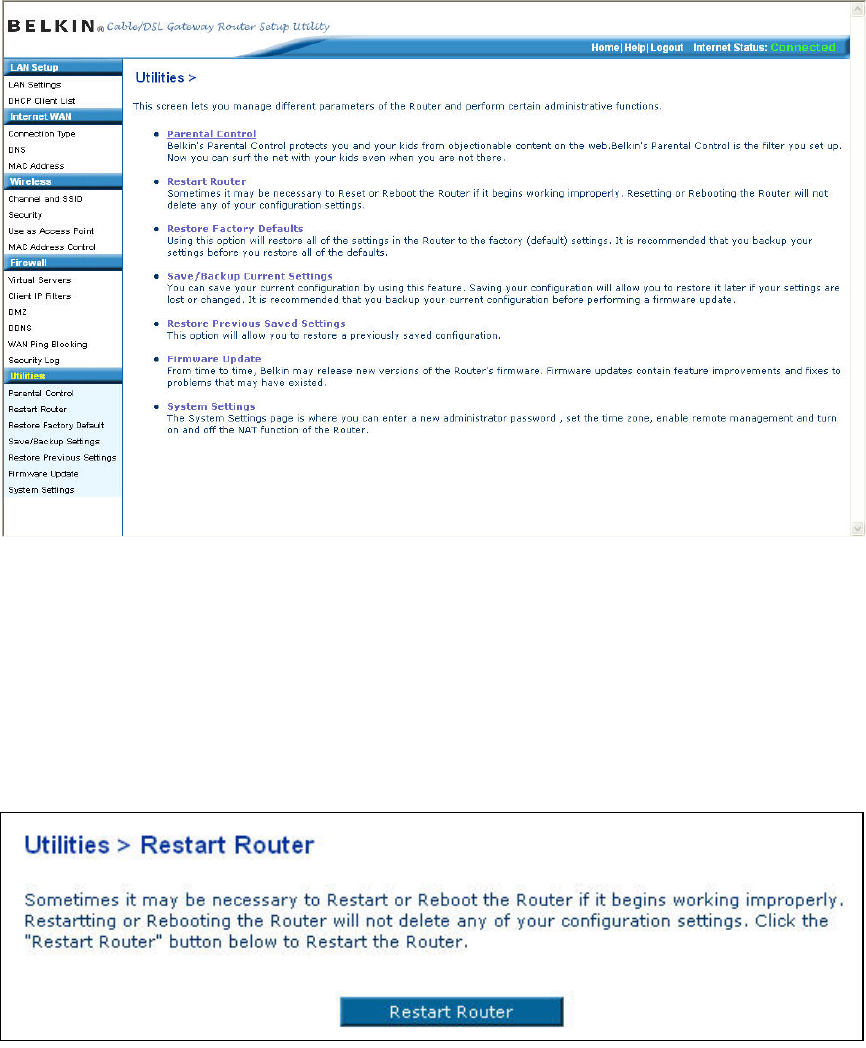
Parental Control
See the included Parental Control User Manual for more information on the
Parental Control feature.
Restarting the Router
Sometimes it may be necessary to restart or reboot the Router if it begins
working improperly. Restarting or rebooting the Router will NOT delete any of
your configuration settings.
Restarting the Router to Restore Normal Operation
1. Click the “Restart Router” button.
N1 Wireless Router.doc Page 59 of 100
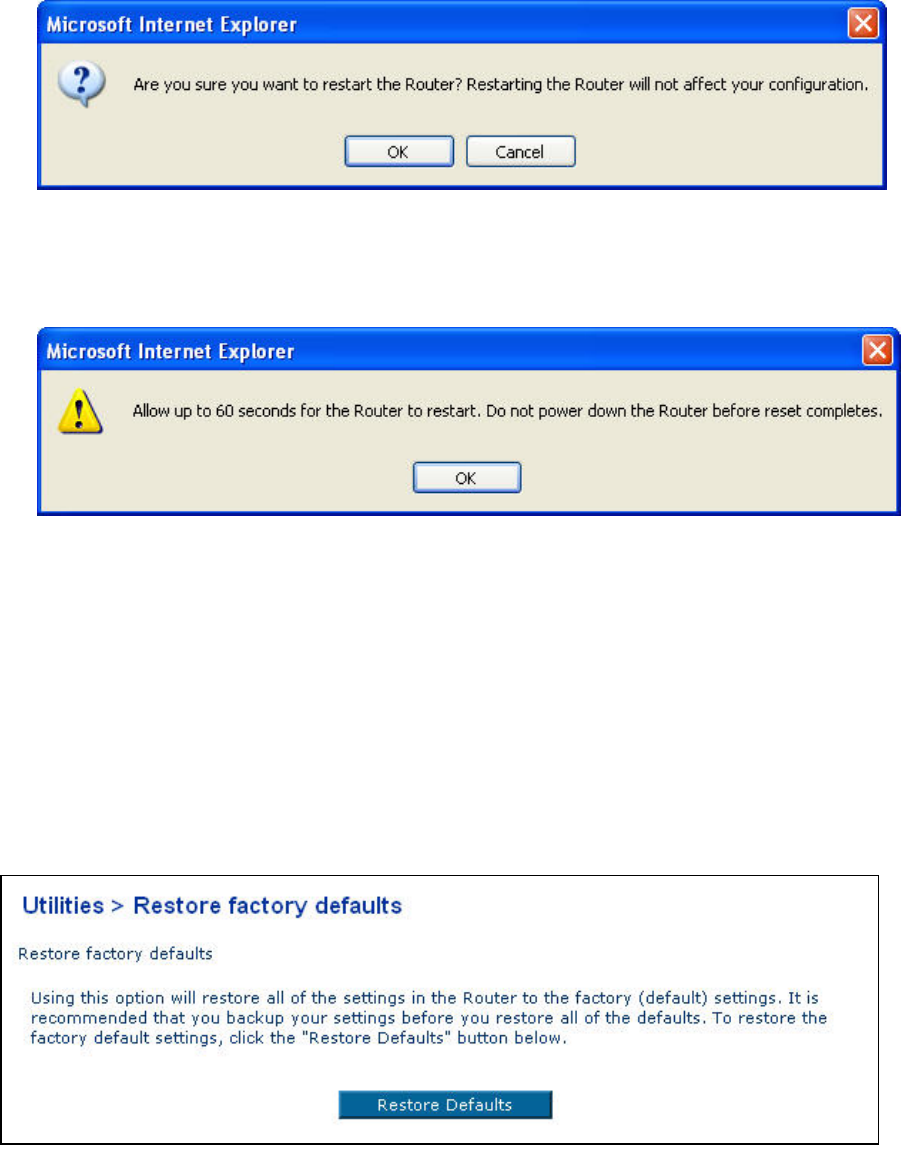
N1 Wireless Router.doc Page 60 of 100
2. The following message will appear. Click “OK”.
3. The following message will appear. Restarting the Router can take up to 60
seconds. It is important not to turn off the power to the Router during the
restart.
4. A 60-second countdown will appear on the screen. When the countdown
reaches zero, the Router will be restarted. The Router home page should
appear automatically. If not, type in the Router’s address (default =
192.168.2.1) into the navigation bar of your browser.
Restoring Factory Default Settings
Using this option will restore all of the settings in the Router to the factory
(default) settings. It is recommended that you back up your settings before you
restore all of the defaults.
1. Click the “Restore Defaults” button.
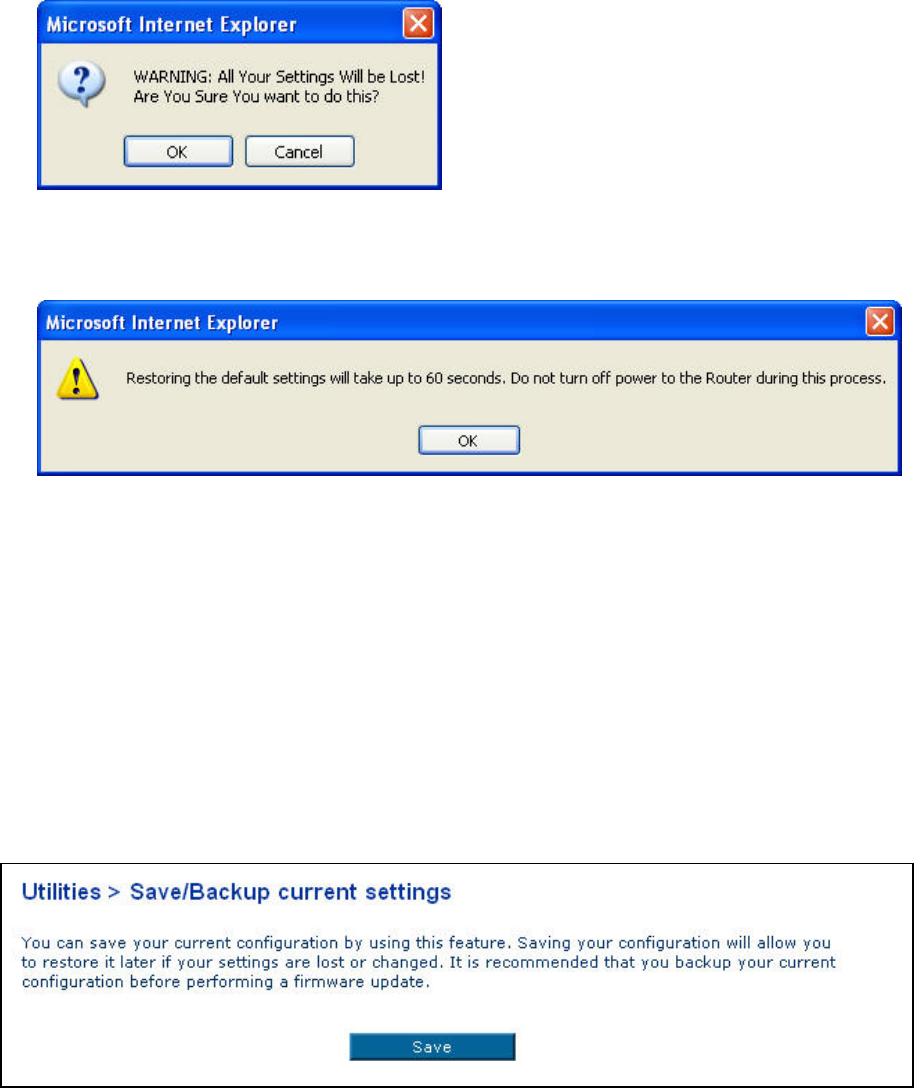
2. The following message will appear. Click “OK”.
3. The following message will appear. Restoring the defaults includes restarting
the Router. It can take up to 60 seconds. It is important not to turn the power
to the Router off during the restart.
4. A 60-second countdown will appear on the screen. When the countdown
reaches zero, the Router’s defaults will be restored. The Router home page
should appear automatically. If it does not, type in the Router’s address
(default = 192.168.2.1) into the navigation bar of your browser.
Saving a Current Configuration
You can save your current configuration by using this feature. Saving your
configuration will allow you to restore it later if your settings are lost or changed.
It is recommended that you back up your current configuration before performing
a firmware update.
N1 Wireless Router.doc Page 61 of 100
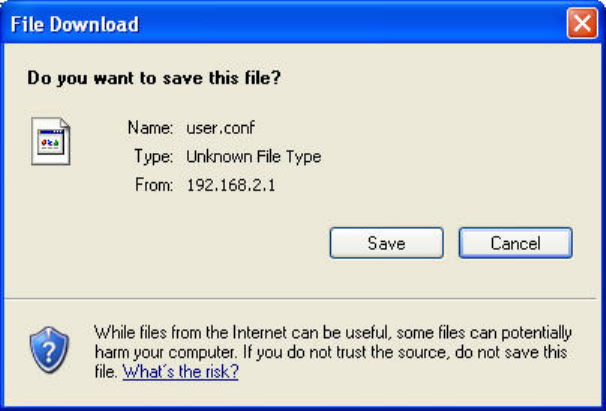
N1 Wireless Router.doc Page 62 of 100
1. Click “Save”. A window called “File Download” will open. Click “Save”.
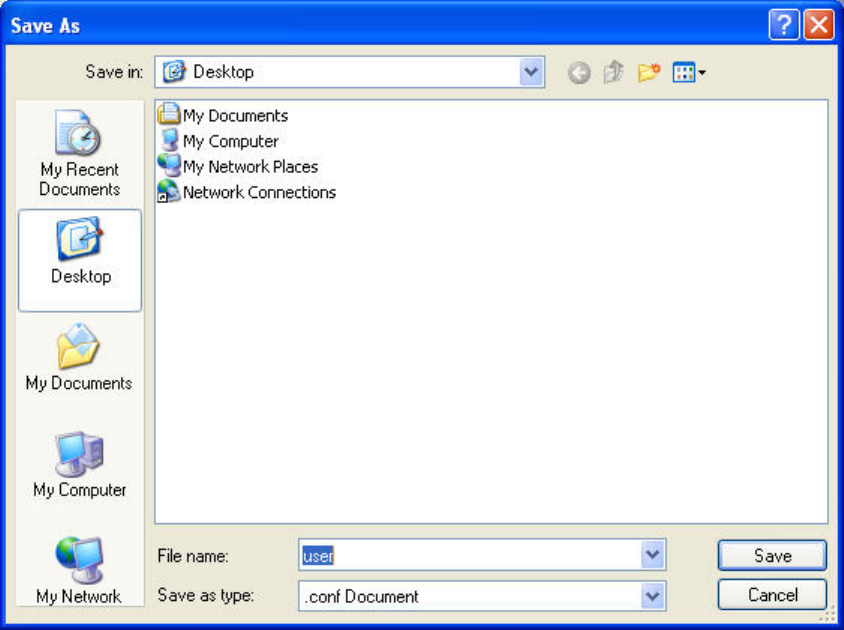
2. A window will open that allows you to select the location where you want to
save the configuration file. Select a location. You can name the file anything
you want, or use the default name “Config”. Be sure to name the file so you
can locate it yourself later. When you have selected the location and name of
the file, click “Save”.
N1 Wireless Router.doc Page 63 of 100
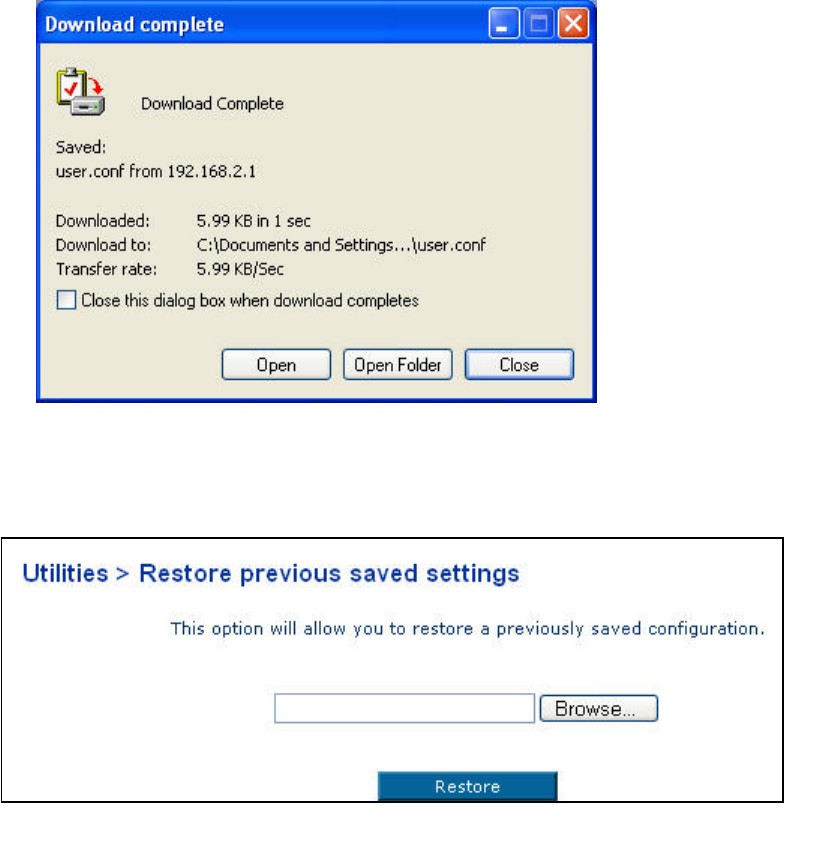
N1 Wireless Router.doc Page 64 of 100
3. When the save is complete, you will see the window below. Click “Close”.
The configuration is now saved.
Restoring a Previous Configuration
This option will allow you to restore a previously saved configuration.
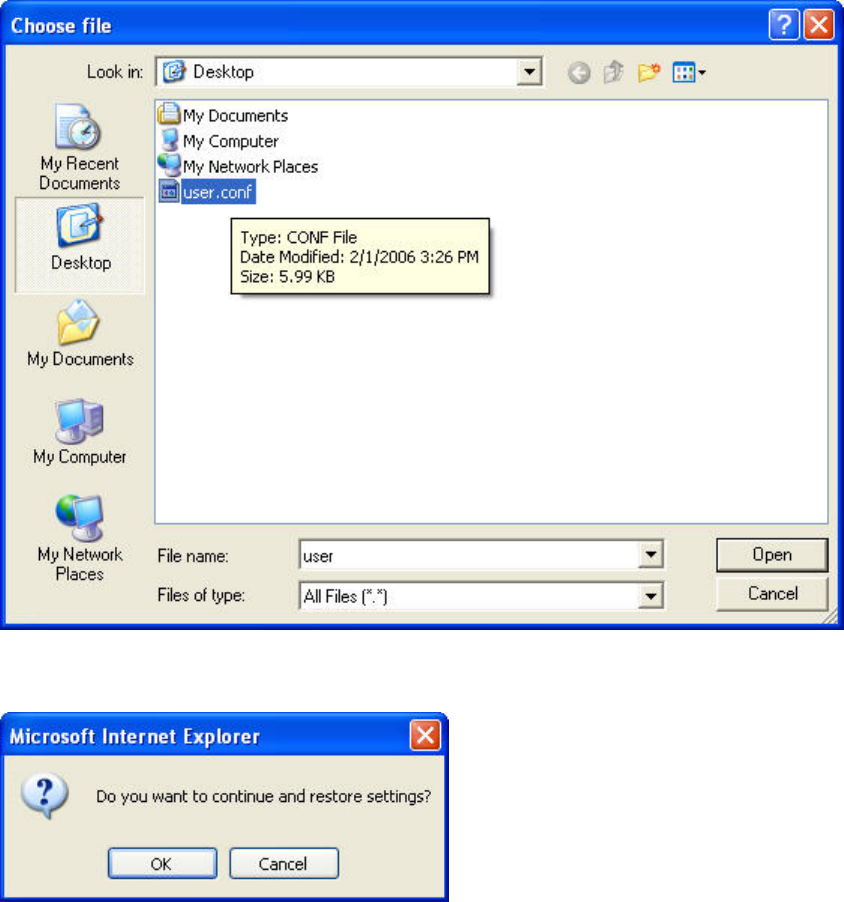
1. Click “Browse”. A window will open that allows you to select the location of
the configuration file. All configuration files end with a “.bin”. Locate the
configuration file you want to restore and double-click on it.
2. You will be asked if you want to continue. Click “OK”.
3. A reminder window will appear. It will take up to 60 seconds for the
configuration restoration to complete. Click “OK”.
N1 Wireless Router.doc Page 65 of 100
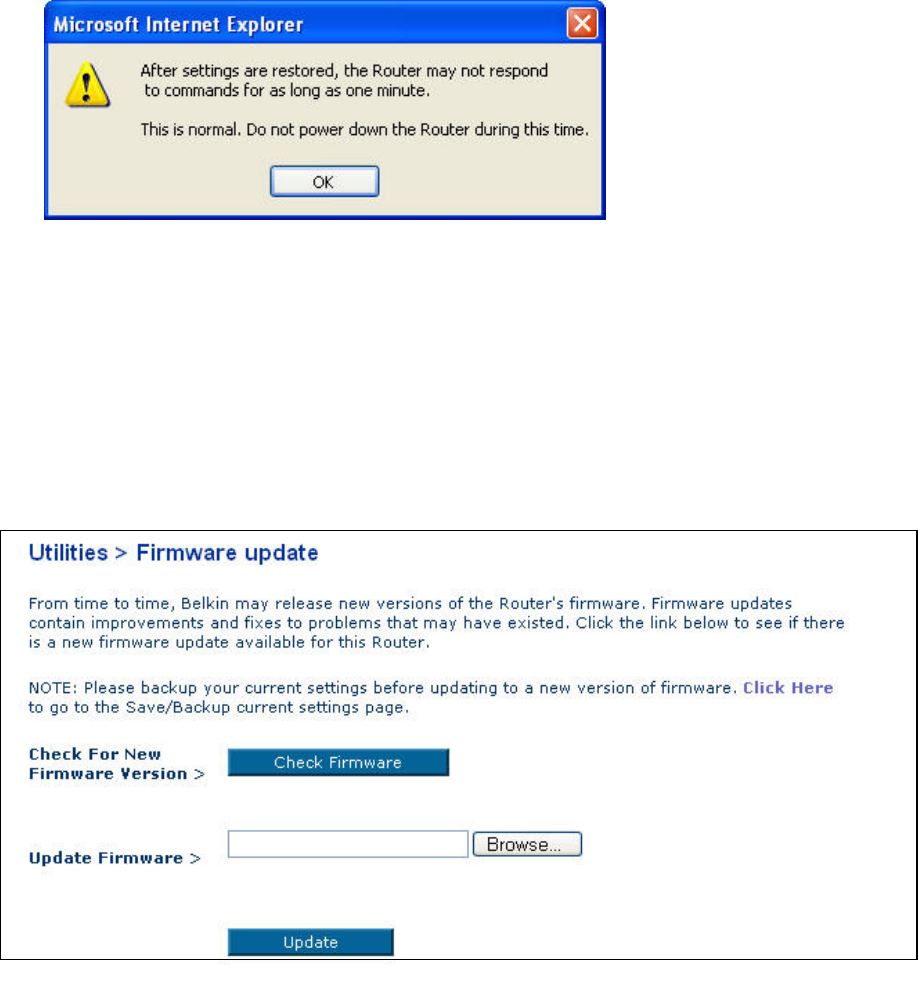
N1 Wireless Router.doc Page 66 of 100
A 60-second countdown will appear on the screen. When the countdown
reaches zero, the Router’s configuration will be restored. The Router’s home
page should appear automatically. If not, type in the Router’s address (default
= 192.168.2.1) into the navigation bar of your browser.
Updating the Firmware
From time to time, Belkin may release new versions of the Router’s firmware.
Firmware updates contain feature improvements and fixes to problems that may
have existed. When Belkin releases new firmware, you can download the
firmware from the Belkin update website and update your Router’s firmware to
the latest version.
Checking for a New Version of Firmware
The “Check Firmware” (1) button allows you to instantly check for a new version
of firmware. When you click the button, a new browser window will appear
informing you that either no new firmware is available or that there is a new
version available. If a new version is available, you will have the option to
download it.
Downloading a New Version of Firmware
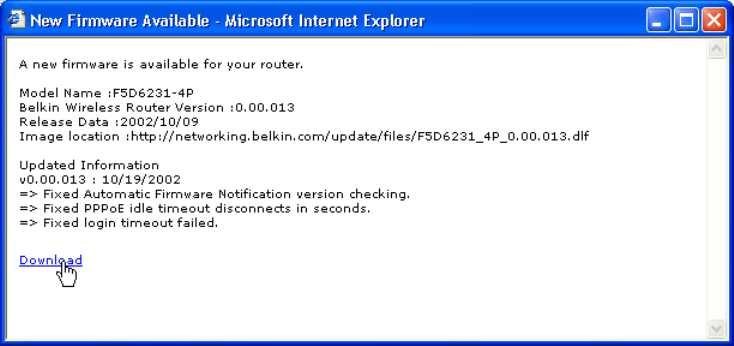
If you click the “Check Firmware” button and a new version of firmware is
available, you will see a screen similar to the one below:
[use current image]
1. To download the new version of firmware, click “Download”.
N1 Wireless Router.doc Page 67 of 100
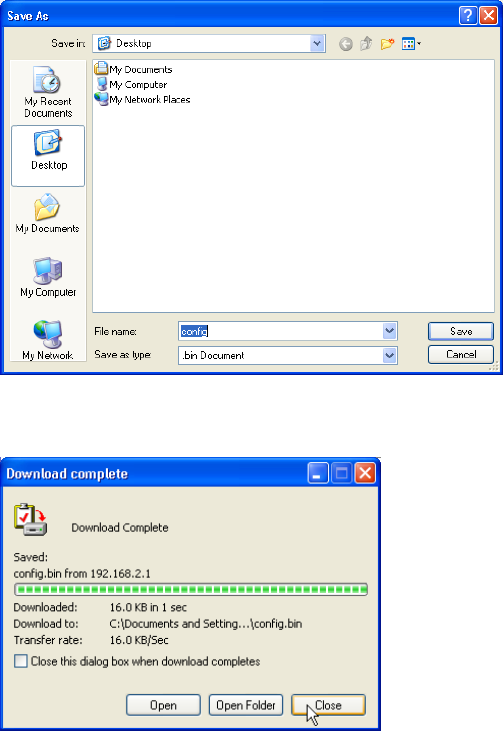
N1 Wireless Router.doc Page 68 of 100
2. A window will open that allows you to select the location where you want to
save the firmware file. Select a location. You can name the file anything you
want, or use the default name. Be sure to locate the file in a place where you
can locate it yourself later. When you have selected the location, click “Save”.
3. When the save is complete, you will see the following window. Click “Close”.
The download of the firmware is complete. To update the firmware, follow the
next steps in “Updating the Router’s Firmware”.
Updating the Router’s Firmware
1. In the “Firmware Update” page, click “Browse” (2). A window will open that
allows you to select the location of the firmware update file.
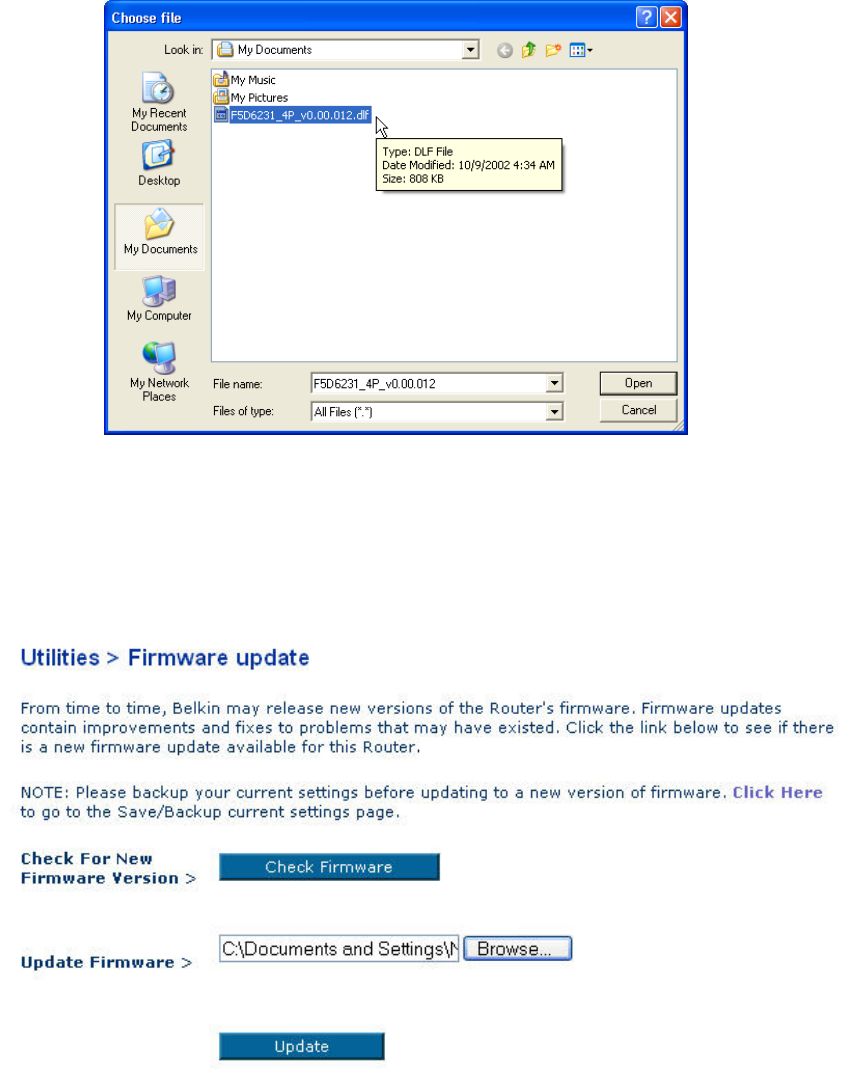
2. Browse to the firmware file you downloaded. Select the file by double-clicking
on the file name.
3. The “Update Firmware” box will now display the location and name of the
firmware file you just selected. Click “Update”.
N1 Wireless Router.doc Page 69 of 100
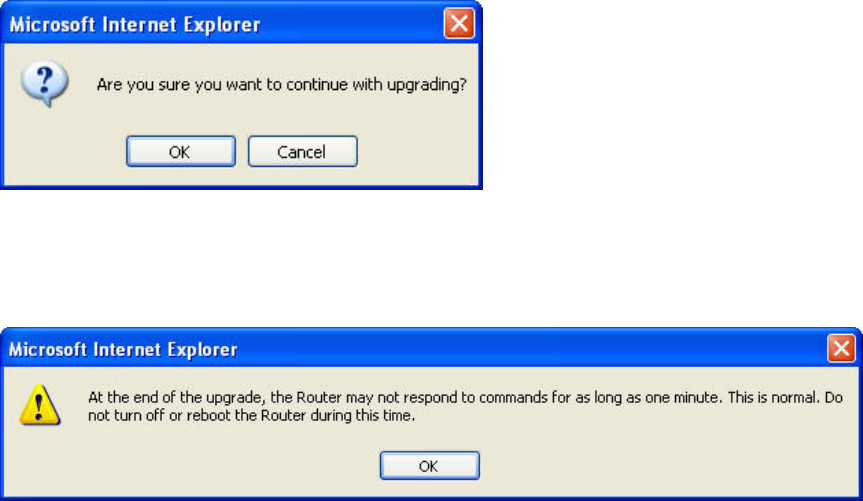
N1 Wireless Router.doc Page 70 of 100
4. You will be asked if you are sure you want to continue. Click “OK”.
5. You will see one more message. This message tells you that the Router may
not respond for as long as one minute as the firmware is loaded into the
Router and the Router is rebooted. Click “OK”.
6. A 60-second countdown will appear on the screen. When the countdown
reaches zero, the Router firmware update will be complete. The Router home
page should appear automatically. If not, type in the Router’s address (default
= 192.168.2.1) into the navigation bar of your browser.
Changing System Settings
The “System Settings” page is where you can enter a new administrator
password, set the time zone, enable remote management, and turn on and off
the NAT function of the Router.
Setting or Changing the Administrator Password
The Router ships with NO password entered. If you wish to add a password for
greater security, you can set a password here. Write down your password and
keep it in a safe place, as you will need it if you need to log into the Router in the
future. It is also recommended that you set a password if you plan to use the
remote management feature of your Router.

Changing the Login Time-Out Setting
The login time-out option allows you to set the period of time that you can be
logged into the Router’s advanced setup interface. The timer starts when there
has been no activity. For example, imagine you have made some changes in the
advanced setup interface, then left your computer alone without clicking “Logout”.
Assuming the time-out is set to 10 minutes, 10 minutes after you leave, the login
session will expire. You will have to log into the Router again to make any more
changes. The login time-out option is for security purposes and the default is set
to 10 minutes. Note: Only one computer can be logged into the Router’s
advanced setup interface at one time.
Setting the Time and Time Zone
The Router keeps time by connecting to a Simple Network Time Protocol (SNTP)
server. This allows the Router to synchronize the system clock to the global
Internet. The synchronized clock in the Router is used to record the security log
and control client filtering. Select the time zone that you reside in. You have the
option to select a primary and a backup NTP server to keep your Router’s clock
synchronized. Select your desired NPT server from the drop-down box, or simply
keep it as is.
If you reside in an area that observes daylight saving, then place a check mark in
the box next to “Enable Daylight Saving”. The system clock may not update
immediately. Allow at least 15 minutes for the Router to contact the time servers
on the Internet and get a response. You cannot set the clock yourself.
N1 Wireless Router.doc Page 71 of 100
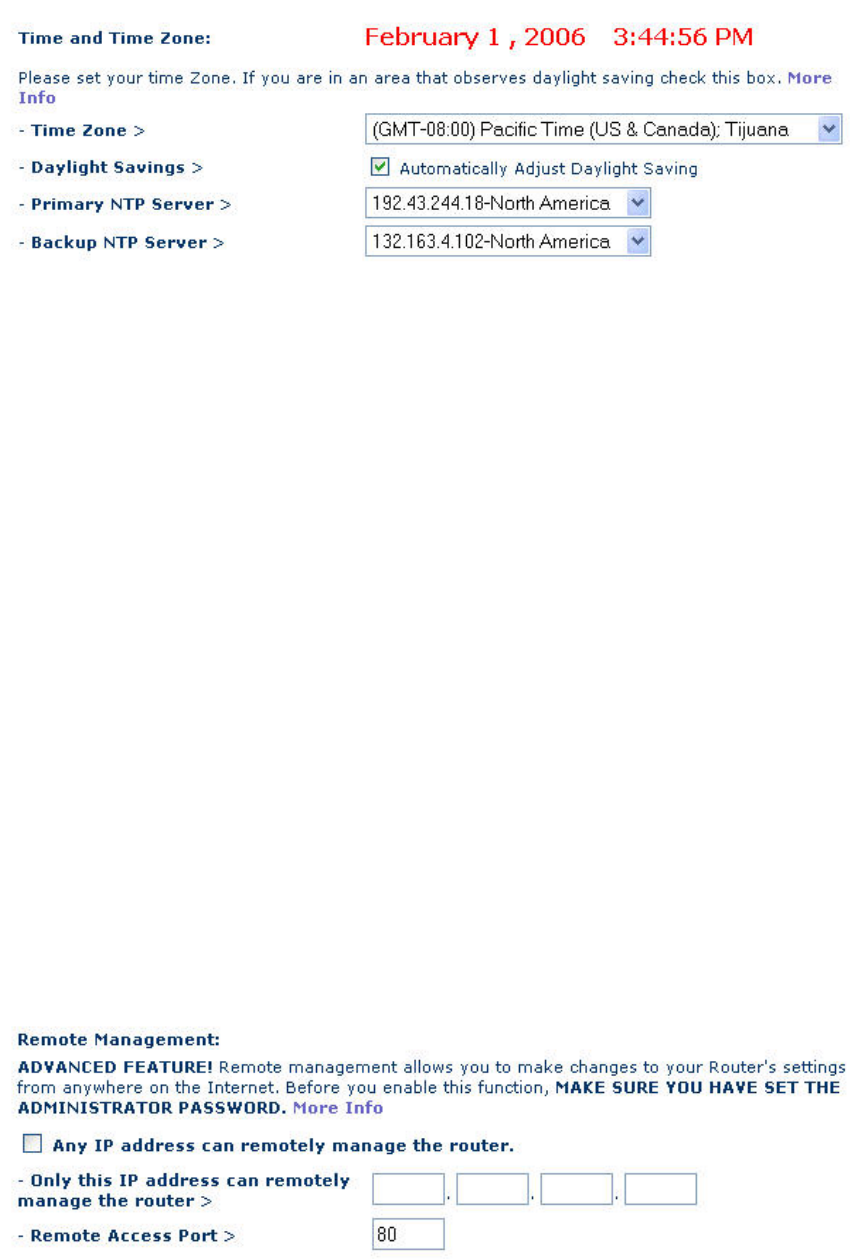
N1 Wireless Router.doc Page 72 of 100
Enabling Remote Management
Before you enable this advanced feature of your Belkin Router, MAKE SURE
YOU HAVE SET THE ADMINISTRATOR PASSWORD. Remote management
allows you to make changes to your Router’s settings from anywhere on the
Internet. There are two methods of remotely managing the Router. The first is to
allow access to the Router from anywhere on the Internet by selecting “Any IP
address can remotely manage the Router”. By typing in your WAN IP address
from any computer on the Internet, you will be presented with a login screen
where you need to type in the password of your Router.
The second method is to allow a specific IP address only to remotely manage the
Router. This is more secure, but less convenient. To use this method, enter the
IP address you know you will be accessing the Router from in the space provided
and select “Only this IP address can remotely manage the Router”. Before you
enable this function, it is STRONGLY RECOMMENDED that you set your
administrator password. Leaving the password empty will potentially open your
Router to intrusion.
Advanced Feature: The “Remote Access Port” option allows you to configure the
desired “Remote Access Port for Remote Management” feature. The default
access port is set to port 80.
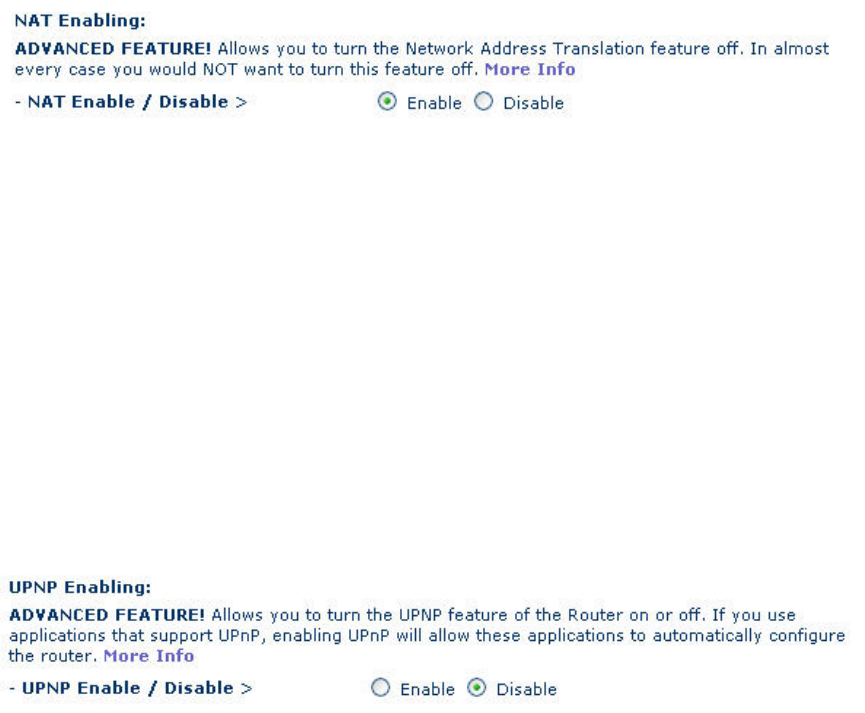
Enabling/Disabling NAT (Network Address Translation)
Note: This advanced feature should be employed by advanced users only.
Before enabling this function, MAKE SURE YOU HAVE SET THE
ADMINISTRATOR PASSWORD. Network Address Translation (NAT) is the
method by which the Router shares the single IP address assigned by your ISP
with the other computers on your network. This function should only be used if
your ISP assigns you multiple IP addresses or you need NAT disabled for an
advanced system configuration. If you have a single IP address and you turn
NAT off, the computers on your network will not be able to access the Internet.
Other problems may also occur. Turning off NAT will not affect your firewall
functions.
Enabling/Disabling UPnP
UPnP (Universal Plug-and-Play) is yet another advanced feature offered by your
Belkin Router. It is a technology that offers seamless operation of voice
messaging, video messaging, games, and other applications that are UPnP-
compliant. Some applications require the Router’s firewall to be configured in a
specific way to operate properly. This usually requires opening TCP and UDP
ports, and in some instances, setting trigger ports. An application that is UPnP-
compliant has the ability to communicate with the Router, basically “telling” the
Router which way it needs the firewall configured. The Router ships with the
UPnP feature disabled. If you are using any applications that are UPnP-
compliant, and wish to take advantage of the UPnP features, you can enable the
UPnP feature. Simply select “Enable” in the “UPnP Enabling” section of the
“Utilities” page. Click “Apply Changes” to save the change.
Enabling/Disabling Auto Firmware Update
This innovation provides the Router with the built-in capability to automatically
check for a new version of firmware and alert you that the new firmware is
available. When you log into the Router’s advanced interface, the Router will
N1 Wireless Router.doc Page 73 of 100

N1 Wireless Router.doc Page 74 of 100
perform a check to see if new firmware is available. If so, you will be notified. You
can choose to download the new version or ignore it.
Manually Configuring Network Settings
Set up the computer that is connected to the cable or DSL modem FIRST using
these steps. You can also use these steps to add computers to your Router after
the Router has been set up to connect to the Internet.
Manually Configuring Network Settings in Mac OS up to 9.x
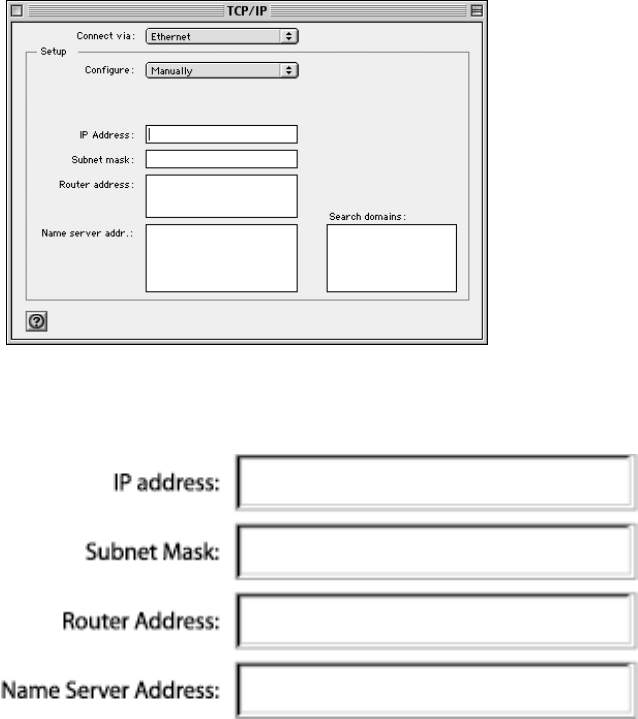
1. Pull down the Apple menu. Select “Control Panels” and select “TCP/IP”.
2. You will see the TCP/IP control panel. Select “Ethernet Built-In” or “Ethernet”
in the “Connect via:” drop-down menu (1).
3. Next to “Configure” (2), if “Manually” is selected, your Router will need to be
set up for a static IP connection type. Write the address information in the
table below. You will need to enter this information into the Router.
N1 Wireless Router.doc Page 75 of 100
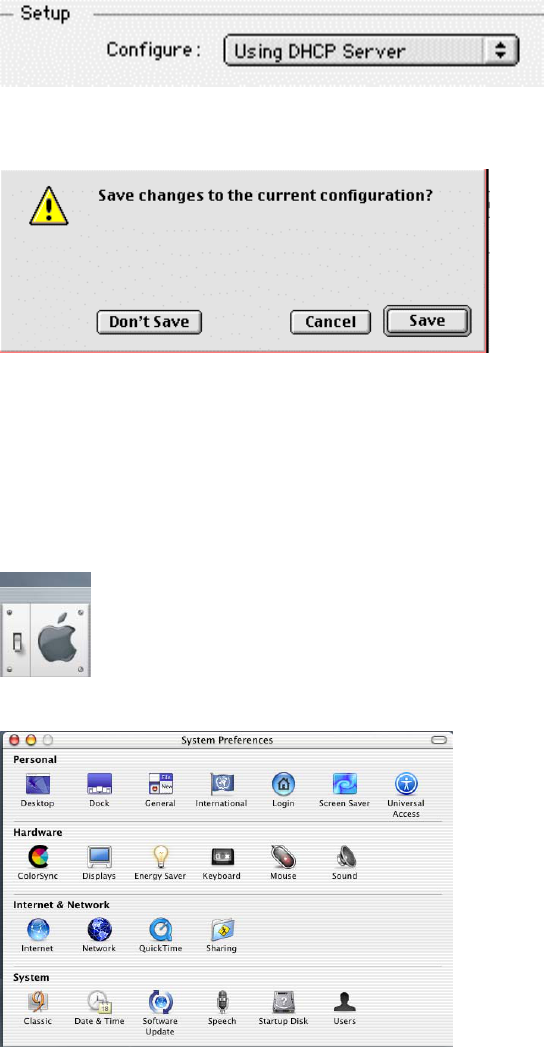
N1 Wireless Router.doc Page 76 of 100
4. If not already set, at “Configure:”, choose “Using DHCP Server”. This will tell
the computer to obtain an IP address from the Router.
5. Close the window. If you made any changes, the following window will
appear. Click “Save”.
Restart the computer. When the computer restarts, your network settings
are now configured for use with the Router.
Manually Configuring Network Settings in Mac OS X
1. Click on the “System Preferences” icon.
2. Select “Network” (1) from the “System Preferences” menu.
2
2
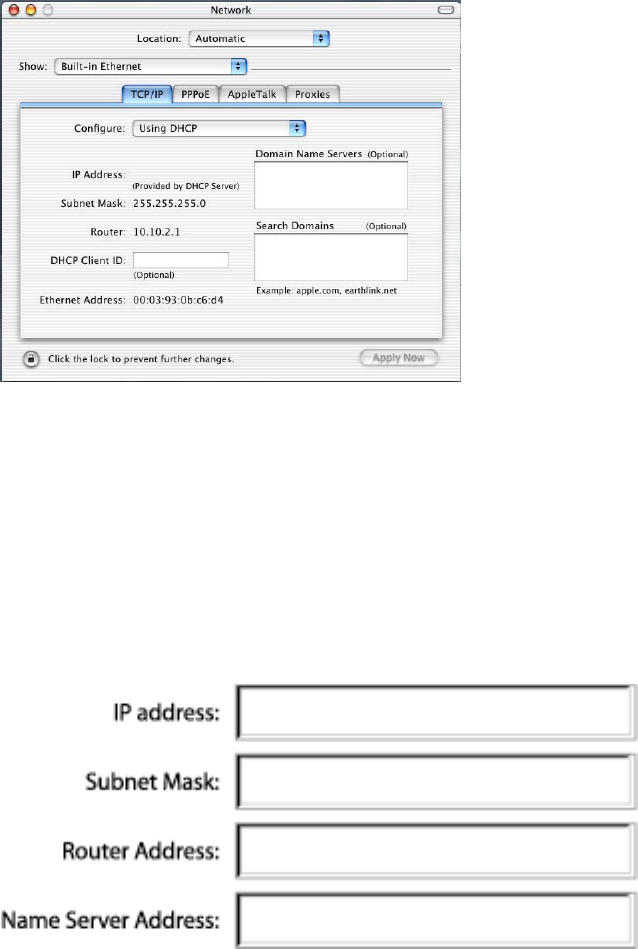
3. Select “Built-in Ethernet” (2) next to “Show” in the Network menu.
4. Select the “TCP/IP” tab (3). Next to “Configure” (4), you should see
“Manually” or “Using DHCP”. If you do not, check the PPPoE tab (5) to make
sure that “Connect using PPPoE” is NOT selected. If it is, you will need to
configure your Router for a PPPoE connection type using your user name
and password.
5. If “Manually” is selected, your Router will need to be set up for a static IP
connection type. Write the address information in the table below. You will
need to enter this information into the Router.
6. If not already selected, select “Using DHCP” next to “Configure” (4), then
click “Apply Now”.
Your network settings are now configured for use with the Router.
Manually Configuring Network Settings in Windows 2000, NT, or XP
N1 Wireless Router.doc Page 77 of 100
N1 Wireless Router.doc Page 78 of 100
1. Click “Start”, “Settings”, then “Control Panel”.
2. Double-click on the “Network and dial-up connections” icon (Windows 2000)
or the “Network” icon (Windows XP).
3. Right-click on the “Local Area Connection” associated with your network
adapter and select “Properties” from the drop-down menu.
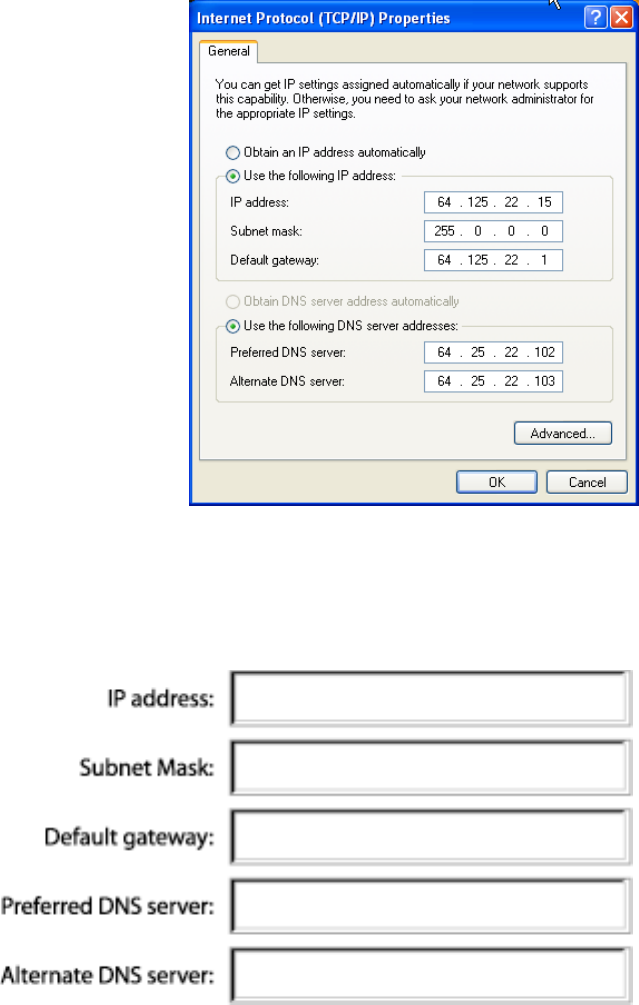
4. In the “Local Area Connection Properties” window, click “Internet Protocol
(TCP/IP)” and click the “Properties” button. The following screen will appear:
5. If “Use the following IP address” (2) is selected, your Router will need to be
set up for a static IP connection type. Write the address information the table
below. You will need to enter this information into the Router.
6. If not already selected, select “Obtain an IP address automatically” (1) and
“Obtain DNS server address automatically” (3). Click “OK”.
Your network settings are now configured for use with the Router.
N1 Wireless Router.doc Page 79 of 100
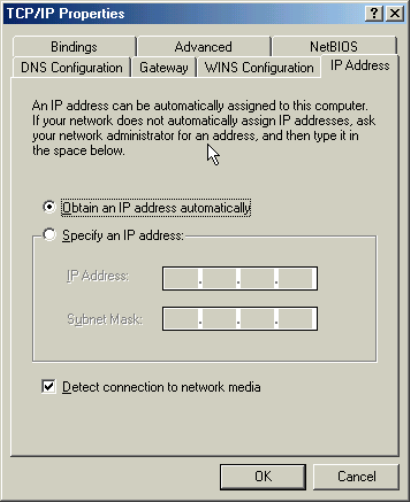
N1 Wireless Router.doc Page 80 of 100
Manually Configuring Network Settings in Windows 98 or Me
1. Right-click on “My Network Neighborhood” and select “Properties” from the
drop-down menu.
2. Select “TCP/IP -> settings” for your installed network adapter. You will see the
following window.
3. If “Specify and IP address” is selected, your Router will need to be set up for
a static IP connection type. Write the address information in the table below.
You will need to enter this information into the Router.
4. Write the IP address and subnet mask from the “IP Address” tab (3).
5. Click the “Gateway” tab (2). Write the gateway address down in the chart.
6. Click the “DNS Configuration” tab (1). Write the DNS address(es) in the chart.
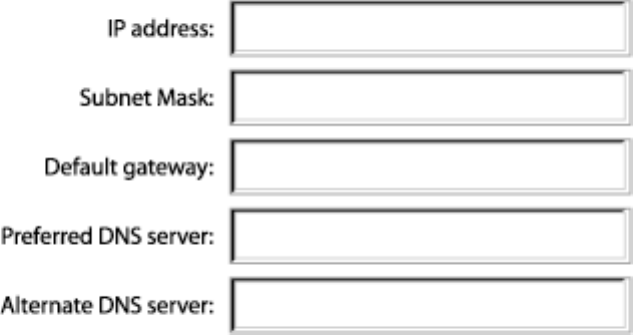
7. If not already selected, select “Obtain IP address automatically” on the IP
address tab. Click “OK”.
Restart the computer. When the computer restarts, your network
settings are now configured for use with the Router.
N1 Wireless Router.doc Page 81 of 100
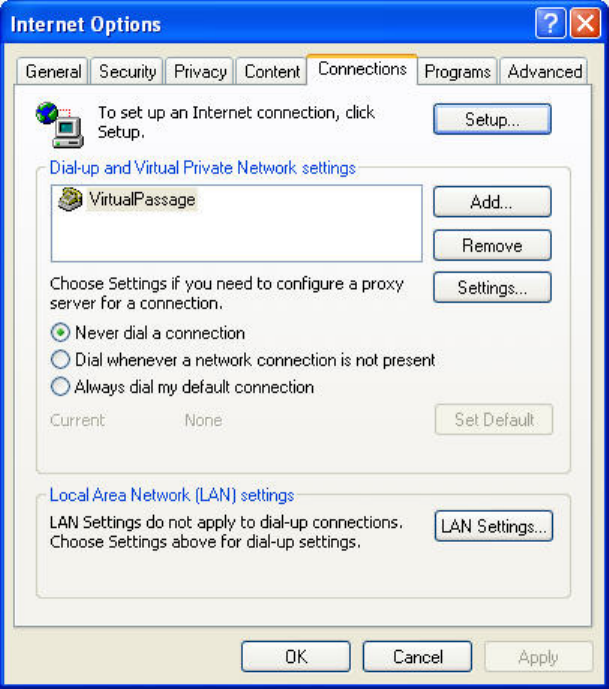
N1 Wireless Router.doc Page 82 of 100
Recommended Web Browser Settings
In most cases, you will not need to make any changes to your web browser’s
settings. If you are having trouble accessing the Internet or the Web-Based
Advanced User Interface, then change your browser’s settings to the
recommended settings in this section.
Microsoft® Internet Explorer 4.0 or Higher
1. Start your web browser. Select “Tools” then “Internet Options”.
IE6_Internet_Options.jpg
2. In the “Internet Options” screen, there are three selections: “Never dial a
connection”, “Dial whenever a network connection is not present”, and
“Always dial my default connection”. If you can make a selection, select
“Never dial a connection”. If you cannot make a selection, go to the next step.
3. Under the “Internet Options” screen, click on “Connections” and select “LAN
Settings…”.
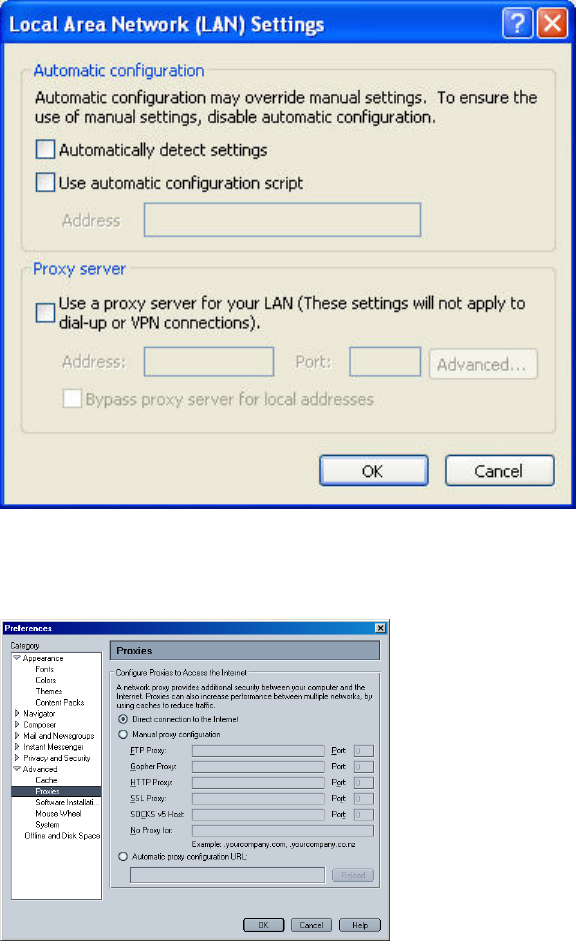
4. Make sure there are no check marks next to any of the displayed options:
“Automatically detect settings”, “Use automatic configuration script”, and “Use
a proxy server”. Click “OK”. Then click “OK” again in the “Internet Options”
page.
Netscape® Navigator® 4.0 or Higher
1. Start Netscape. Click on “Edit” then “Preferences”.
2. In the “Preferences” window, click on “Advanced” then select “Proxies”. In the
“Proxies” window, select “Direct connection to the Internet”.
N1 Wireless Router.doc Page 83 of 100
N1 Wireless Router.doc Page 84 of 100
Troubleshooting
Installation CD does not automatically start.
If the CD-ROM does not start the Easy Install Wizard automatically, it could be
that the computer is running other applications that are interfering with the CD
drive.
1. If the Easy Install Wizard screen does not appear within 15-20 seconds, open
up your CD-ROM drive by double-clicking on the “My Computer” icon that is
located on your desktop.
2. Next, double-click on the CD-ROM drive that the Easy Installation CD has
been placed in to start the installation.
3. The Easy Install Wizard should start within a few seconds. If, instead, a
window appears showing the files on the CD, double-click on the icon labeled
“EasyInstall.exe”.
4. If the Easy Install Wizard still does not start, reference the section titled
“Manually Configuring Network Settings” (page xx [confirm page no. ]) of this
User Manual for an alternative setup method).
Easy Install Wizard cannot find my Router.
If the Easy Install Wizard is not able to find the Router during the installation
process, please check the following items:
1. If the Easy Install Wizard is not able to find the Router during the installation
process, there may be third-party firewall software installed on the computer
attempting to access the Internet. Examples of third-party firewall software
are ZoneAlarm, BlackICE PC Protection, McAfee Personal Firewall, and
Norton Personal Firewall. If you do have firewall software installed on your
computer, please make sure that you properly configure it. You can determine
if the firewall software is preventing Internet access by temporarily turning it
off. If, while the firewall is disabled, Internet access works properly, you will
need to change the firewall settings to function properly when it is turned on.
Please refer to the instructions provided by the publisher of your firewall
software for instructions on configuring the firewall to allow Internet access.
2. Unplug power to the Router for 10 seconds, and then plug the power back
into the Router. Ensure that the Router’s Power light is on; it should be solid
Blue. If not, check to make sure that the AC adapter is connected to the
Router and plugged into a wall outlet.
3. Ensure that you have a cable (use the cable included with the Router)
connected between (1) the network (Ethernet) port on the back of the
computer and (2) one of the LAN ports, labeled “1” through “4”, on the back of
the Router.
Note: The computer should NOT be connected to the port labeled
“Internet/WAN” on the back of the Router.
4. Try shutting down and restarting your computer, then rerunning the Easy
Install Wizard.
If the Easy Install Wizard is still unable to find the Router, reference the section
titled “Manually Configuring Network Settings” for installation steps.
N1 Wireless Router.doc Page 85 of 100
N1 Wireless Router.doc Page 86 of 100
Easy Install cannot connect my Router to the Internet.
If the Easy Install Wizard is not able to connect the Router to the Internet, please
check the following items:
1. Use the troubleshooting suggestions within the Easy Install Wizard. If the
troubleshooting screen does not open automatically, click on the
“Troubleshoot” button in the lower, right-hand corner of the Easy Install
Wizard window.
2. If your ISP requires a user name and password, make sure that you have
typed in your user name and password correctly. Some user names require
that the ISP’s domain may be at the end of the name. Example:
“myname@myisp.com”. The “@myisp.com” part of the user name may need
to be typed as well as your user name.
If you continue to have no Internet connection, reference the section titled
“Manually Configuring Network Settings” (page xx of this User Manual for an
alternative setup method).
• The Easy Install Wizard completed installation, but my web browser
doesn’t work.
• I am unable to connect to the Internet. The “WAN” light on my Router is
off, and the “Connected” light is blinking.
If you cannot connect to the Internet, and the “WAN” light is off, and the
“Connected” light is blinking, the problem may be that your modem and Router
are not connected properly.
1. Make sure the network cable between the modem and the Router is
connected. We strongly recommend using the cable that was supplied with
your cable or DSL modem for this purpose. The cable should be connected at
one end to the Router’s “Internet/WAN” port, and at the other end to the
network port on your modem.
2. Unplug the cable or DSL modem from its power source for three minutes.
After three minutes, plug the modem back into its power source. This may
force the modem to properly recognize the Router.
3. Unplug the power to your Router, wait 10 seconds, and then reconnect the
power. This will cause the Router to reattempt communication with the
modem. If the “WAN” light on the Router is not lit after completing these
steps, please contact Belkin Technical Support.
4. Try shutting down and restarting your computer.
• The Easy Install Wizard completed installation, but my web browser
doesn’t work.
• I am unable to connect to the Internet. The “WAN” light on my Router is
on, and the “Connected” light is blinking.
1. If you cannot connect to the Internet, the “WAN” light is on, and the
“Connected” light is blinking, the problem may be that your connection type
may not match the ISP’s connection.
2. If you have a “static IP address” connection, your ISP must assign you the IP
address, subnet mask, and gateway address. Please refer to the section
entitled “Alternate Setup Method” for details on changing this setting.
3. If you have a “PPPoE” connection, your ISP will assign you a user name and
password and sometimes a service name. Make sure the Router’s connection
type is configured to PPPoE and the settings are entered properly. Please
refer to the section entitled “Alternate Setup Method” for details on changing
this setting.
N1 Wireless Router.doc Page 87 of 100
N1 Wireless Router.doc Page 88 of 100
4. You may need to configure your Router to meet the specific requirements of
your ISP. To search our knowledge base for ISP-specific issues, go to:
http://web.belkin.com/support and type in “ISP”.
If you are still unable to access the Internet after verifying these settings, please
contact Belkin Technical Support.
• The Easy Install Wizard completed, but my web browser doesn’t work.
• I am unable to connect to the Internet. The “WAN” light on my Router is
blinking, and the “Connected” light is solid.
1. If the “WAN” light is blinking, and the “Connected” light is solid, but you are
unable to access the Internet, there may be third-party firewall software
installed on the computer attempting to access the Internet. Examples of
third-party firewall software are ZoneAlarm, BlackICE PC Protection, McAfee
Personal Firewall, and Norton Personal Firewall.
2. If you do have firewall software installed on your computer, please make sure
that you properly configure it. You can determine if the firewall software is
preventing Internet access by temporarily turning it off. If, while the firewall is
disabled, Internet access works properly, you will need to change the firewall
settings to function properly when it is turned on.
3. Please refer to the instructions provided by the publisher of your firewall
software for instructions on configuring the firewall to allow Internet access.
If you are still unable to access the Internet after disabling any firewall software,
please contact Belkin Technical Support.
I can’t connect to the Internet wirelessly.
If you are unable to connect to the Internet from a wireless computer, please
check the following items:
1. Look at the lights on your Router. If you’re using a Belkin Router, the lights
should be as follows:
• The “Power” light should be on.
• The “Connected” light should be on, and not blinking.
• The “WAN Internet” light should be either on or blinking.
* The “Wireless” light should be on or blinking
2. Open your wireless utility software by clicking on the icon in the system tray at
the bottom, right-hand corner of the screen.
3. The exact window that opens will vary depending on the model of wireless
card you have; however, any of the utilities should have a list of “Available
Networks”—those wireless networks it can connect to.
Does the name of your wireless network appear in the results?
Yes, my network name is listed—go to the troubleshooting solution titled “I can’t
connect to the Internet wirelessly, but my network name is listed”.
No, my network name is not listed—go to the troubleshooting solution titled “I
can’t connect to the Internet wirelessly, and my network name is not listed”.
N1 Wireless Router.doc Page 89 of 100
N1 Wireless Router.doc Page 90 of 100
I can’t connect to the Internet wirelessly, but my network name is listed.
If the name of your network is listed in the “Available Networks” list, please follow
the steps below to connect wirelessly:
1. Click on the correct network name in the “Available Networks” list.
2. If the network has security (encryption) enabled, you will need to enter the
network key. For more information regarding security, see the section entitled
“Setting WEP Encryption”.
3. Within a few seconds, the tray icon in the lower, left-hand corner of your
screen should turn Blue, indication of a successful connection to the network.
I can’t connect to the Internet wirelessly, and my network name is not
listed.
If the correct network name is not listed under “Available Networks” in the
wireless utility, please attempt the following troubleshooting steps:
1. Temporarily move computer, if possible, five to 10 feet from the Router. Close
the wireless utility, and reopen it. If the correct network name now appears
under “Available Networks”, you may have a range or interference problem.
Please see the suggestions discussed in the section titled “Placement of your
N1 Wireless Router” of this User Manual.
2. Using a computer that is connected to the Router via a network cable (as
opposed to wirelessly), ensure that “Broadcast SSID” is enabled. This setting
is found on the Router’s wireless “Channel and SSID” configuration page.
If you are still unable to access the Internet after completing these steps, please
contact Belkin Technical Support.
• My wireless network performance is inconsistent.
• Data transfer is sometimes slow.
• Signal strength is poor.
• Difficulty establishing and/or maintaining a Virtual Private Network
(VPN) connection.
Wireless technology is radio-based, which means connectivity and the
throughput performance between devices decreases when the distance between
devices increases. Other factors that will cause signal degradation (metal is
generally the worst culprit) are obstructions such as walls and metal appliances.
Note also that connection speed may decrease as you move farther away from
the Router (or access point).
In order to determine if wireless issues are related to range, we suggest
temporarily moving the computer, if possible, five to 10 feet from the Router.
Changing the wireless channel—Depending on local wireless traffic and
interference, switching the wireless channel of your network can improve
performance and reliability. The default channel the Router is shipped with is
channel 11; you may choose from several other channels depending on your
region. See the section entitled “Changing the Wireless Channel” for instructions
on how to choose other channels.
Limiting the wireless transmit rate—Limiting the wireless transmit rate can help
improve the maximum wireless range and connection stability. Most wireless
cards have the ability to limit the transmission rate. To change this property, go to
the Windows Control Panel, open “Network Connections” and double-click on
your wireless card’s connection. In the properties dialog, select the “Configure”
button on the “General” tab (Windows 98 users will have to select the wireless
card in the list box and then click “Properties”), then choose the “Advanced” tab
and select the rate property.
Wireless client cards are usually set to automatically adjust the wireless transmit
rate for you, but doing so can cause periodic disconnects when the wireless
signal is too weak; as a rule, slower transmission rates are more stable.
Experiment with different connection rates until you find the best one for your
environment. Note that all available transmission rates should be acceptable for
browsing the Internet. For more assistance, see your wireless card’s user
manual.
N1 Wireless Router.doc Page 91 of 100
N1 Wireless Router.doc Page 92 of 100
I am having difficulty setting up Wired Equivalent Privacy (WEP) security
on a Belkin Router (or Belkin Access Point).
1. Log into your Wireless Router or (Access Point).
Open your web browser and type in the IP address of the Wireless Router (or
Access Point). (The Router’s default is 192.168.2.1, the 802.11g Access Point
is 192.168.2.254.) Log into your Router by clicking on the “Login” button in the
top right-hand corner of the screen. You will be asked to enter your password.
If you never set a password, leave the “Password” field blank and click
“Submit”.
Click the “Wireless” tab on the left of your screen. Select the “Encryption” or
“Security” tab to get to the security settings page.
2. Select “128-bit WEP” from the drop-down menu.
3. After selecting your WEP encryption mode, you can type in your hex WEP
key manually, or you can type in a passphrase in the “Passphrase” field and
click “Generate” to create a WEP key from the passphrase. Click “Apply
Changes” to finish. You must now set all of your clients to match these
settings. A hex (hexadecimal) key is a mixture of numbers and letters from A-
F and 0-9. For 128-bit WEP, you need to enter 26 hex keys.
For example:
C3 03 0F AF 4B B2 C3 D4 4B C3 D4 E7 E4 = 128-bit key
4. Click “Apply Changes” to finish. Encryption in the Wireless Router is now set.
Each of your computers on your wireless network will now need to be
configured with the same security settings.
WARNING: If you are configuring the Wireless Router (or Access Point) from a
computer with a wireless client, you will need to ensure that security is turned on
for this wireless client. If this is not done, you will lose your wireless connection.
Note to Mac Users: Original Apple AirPort products support 64-bit encryption
only. Apple AirPort 2 products can support 64-bit or 128-bit encryption. Please
check your Apple AirPort product to see which version you are using. If you
cannot configure your network with 128-bit encryption, try 64-bit encryption.
I am having difficulty setting up Wired Equivalent Privacy (WEP) security
on a Belkin client card.
The client card must use the same key as the Wireless Router (or access point).
For instance, if your Wireless Router (or access point) uses the key
00112233445566778899AABBCC, then the client card must be set to the exact
same key.
1. Double-click the Signal Indicator icon to bring up the “Wireless Network”
screen.

2. The “Advanced” button will allow you to view and configure more options of
your card.
3. Once the “Advanced” button is clicked, the Belkin Wireless LAN Utility will
appear. This Utility will allow you to manage all the advanced features of the
Belkin Wireless Card.
4. Under the “Wireless Network Properties” tab, select a network name from the
“Available Networks” list and click the “Properties” button.
5. Under “Data Encryption”, select “WEP”.
6. Ensure that the check box “The key is provided for me automatically” at the
bottom is unchecked. If you are using this computer to connect to a corporate
network, please consult your network administrator if this box needs to be
checked.
7. Type your WEP key in the “Network key” box.
Important: A WEP key is a mixture of numbers and letters from A-F and 0-9. For
128-bit WEP, you need to enter 26 keys. This network key needs to match the
key you assign to your Wireless Router (or access point).
For example:
C3 03 0F AF 4B B2 C3 D4 4B C3 D4 E7 E4 = 128-bit key
8. Click “OK”, and then “Apply” to save the settings.
If you are not using a Belkin wireless client card, please consult the
manufacturer’s user manual for that wireless client card.
Do Belkin products support WPA?
Note: To use WPA security, all your clients must be upgraded to drivers and
software that support it. At the time of this FAQ publication, a security patch
download is available, for free, from Microsoft. This patch works only with the
Windows XP operating system.
Download the patch here: [url]
You also need to download the latest driver for your Belkin 802.11g Wireless
Desktop or Notebook Network Card from the Belkin support site. Other operating
systems are not supported at this time. Microsoft’s patch only supports devices
with WPA-enabled drivers such as Belkin 802.11g products.
Download the latest driver at http://web.belkin.com/support for the following
products:
F5D7000, F5D7001, F5D7010, F5D7230-4, F5D7231-4, F5D7130
N1 Wireless Router.doc Page 93 of 100
N1 Wireless Router.doc Page 94 of 100
I am having difficulty setting up Wireless Protected Access (WPA) security
on a Belkin Wireless Router (or Belkin Access Point) for a home network.
1. From the “Security Mode” drop-down menu, select “WPA-PSK (no server)”.
2. For “Encryption Technique”, select “TKIP” or “AES”. This setting will have to
be identical on the clients that you set up.
3. Enter your pre-shared key. This can be from eight to 63 characters and can
be letters, numbers, symbols, or spaces. This same key must be used on all
of the clients that you set up. For example, your PSK might be something like:
“Smith family network key”.
4. Click “Apply Changes” to finish. You must now set all clients to match these
settings.
I am having difficulty setting up Wireless Protected Access (WPA) security
on a Belkin wireless client card for a home network.
Clients must use the same key that the Wireless Router (or access point) uses.
For instance, if the key is “Smith Family Network Key” in the Wireless Router (or
access point), the clients must also use that same key.
1. Double-click the Signal Indicator icon to bring up the “Wireless Network”
screen. The “Advanced” button will allow you to view and configure more
options of your card.
2. Once the “Advanced” button is clicked, the Belkin Wireless Utility will appear.
This Utility will allow you to manage all the advanced features of the Belkin
Wireless Card.
3. Under the “Wireless Network Properties” tab, select a network name from the
“Available Networks” list and click the “Properties” button.
4. Under “Network Authentication”, select “WPA-PSK (no server).
5. Type your WPA key in the “Network key” box.
Important: WPA-PSK is a mixture of numbers and letters from A-Z and 0-9. For
WPA-PSK you can enter eight to 63 characters. This network key needs to
match the key you assign to your Wireless Router (or access point).
6. Click “OK, then “Apply” to save the settings.
I am NOT using a Belkin client card for a home network and I am having
difficulty setting up Wireless Protected Access (WPA) security.
If you are not using a Belkin Wireless Desktop or Wireless Notebook Network
Card that is not equipped with WPA-enabled software, a file from Microsoft called
“Windows XP Support Patch for Wireless Protected Access” is available for free
download. Download the patch from Microsoft by searching the knowledge base
for Windows XP WPA.
Note: The file that Microsoft has made available works only with Windows XP.
Other operating systems are not supported at this time. You also need to ensure
that the wireless card’s manufacturer supports WPA and that you have
downloaded and installed the latest driver from their support site.
Supported Operating Systems:
• Windows XP Professional
• Windows XP Home Edition
1. Under Windows XP, click “Start > Control Panel > Network Connections”.
2. Right-clicking on the “Wireless Networks” tab will display the following screen.
Ensure the “Use Windows to configure my wireless network settings” check
box is checked. [need image]
3. Under the “Wireless Networks” tab, click the “Configure” button and you will
see the following screen.
4. For a home or small business user, select “WPA-PSK” under “Network
Administration”.
Note: Select WPA (with radius server) if you are using this computer to connect
to a corporate network that supports an authentication server such as a radius
server. Please consult your network administrator for further information.
5. Select “TKIP” or “AES” under “Date Encryption”. This setting will have to be
identical to the Wireless Router (or access point) that you set up.
6. Type in your encryption key in the “Network key” box.
Important: Enter your pre-shared key. This can be from eight to 63 characters
and can be letters, numbers, or symbols. This same key must be used on all of
the clients that you set up.
7. Click “OK” to apply settings.
N1 Wireless Router.doc Page 95 of 100
N1 Wireless Router.doc Page 96 of 100
Technical Support
You can find technical support information at http://www.belkin.com/networking
or www.belkin.com through the tech support area. If you want to contact
technical support by phone, please call:
US: 877-736-5771 or 310-898-1100 ext. 2263
Europe: 00 800 223 55 460
Australia: 1800 235 546
New Zealand: 0800 235 546
Singapore: 800 616 1790
Information
FCC Statement
DECLARATION OF CONFORMITY WITH FCC RULES FOR
ELECTROMAGNETIC COMPATIBILITY
We, Belkin Corporation, of 501 West Walnut Street, Compton, CA 90220, declare
under our sole responsibility that the product,
F5D8231-4
to which this declaration relates,
complies with Part 15 of the FCC Rules. Operation is subject to the following two
conditions: (1) this device may not cause harmful interference, and (2) this device
must accept any interference received, including interference that may cause
undesired operation.
Caution: Exposure to Radio Frequency Radiation. The radiated output power of
this device is far below the FCC radio frequency exposure limits. Nevertheless,
the device shall be used in such a manner that the potential for human contact
normal operation is minimized.
When connecting an external antenna to the device, the antenna shall be placed
in such a manner to minimize the potential for human contact during normal
operation. In order to avoid the possibility of exceeding the FCC radio frequency
exposure limits, human proximity to the antenna shall not be less than 20cm (8
inches) during normal operation.
Federal Communications Commission Notice
This equipment has been tested and found to comply with the limits for a Class B
digital device, pursuant to Part 15 of the FCC Rules. These limits are designed to
provide reasonable protection against harmful interference in a residential
installation.
This equipment generates, uses, and can radiate radio frequency energy. If this
equipment does cause harmful interference to radio or television reception, which
can be determined by turning the equipment off and on, the user is encouraged
to try and correct the interference by one or more of the following measures:
Belkin declares that F5D8231-4 (FCC ID: K7SF5D8231-4) is limited
in CH1~CH11 for 2.4 GHz by specified firmware controlled in U.S.A.
This transmitter must not be co-located or operating in conjunction with any other antenna or transmitter.
• Reorient or relocate the receiving antenna.
• Increase the distance between the equipment and the receiver.
• Connect the equipment to an outlet on a circuit different from that to which the
receiver is connected.
• Consult the dealer or an experienced radio/TV technician for help.
Modifications
The FCC requires the user to be notified that any changes or modifications to this
device that are not expressly approved by Belkin Corporation may void the user’s
authority to operate the equipment.
Canada-Industry Canada (IC)
The wireless radio of this device complies with RSS 139 & RSS 210 Industry
Canada. This Class B digital apparatus complies with Canadian ICES-003.
Cet appareil numérique de la classe B conforme á la norme NMB-003 du
Canada.
Europe-European Union Notice Radio products with the CE 0682 or CE alert
marking comply with the R&TTE Directive (1995/5/EC) issued by the
Commission of the European Community.
Compliance with this directive implies conformity to the following European
Norms (in brackets are the equivalent international standards).
• EN 60950 (IEC60950) – Product Safety
• EN 300 328 Technical requirement for radio equipment
• ETS 300 826 General EMC requirements for radio equipment.
To determine the type of transmitter, check the identification label on your Belkin
product.
Products with the CE marking comply with the EMC Directive (89/336/EEC) and
the Low Voltage Directive (72/23/EEC) issued by the Commission of the
European Community. Compliance with these directives implies conformity to the
following European Norms (in brackets are the equivalent international
standards).
• EN 55022 (CISPR 22) – Electromagnetic Interference
• EN 55024 (IEC61000-4-2,3,4,5,6,8,11) – Electromagnetic Immunity
• EN 61000-3-2 (IEC610000-3-2) – Power Line Harmonics
• EN 61000-3-3 (IEC610000) – Power Line Flicker
• EN 60950 (IEC60950) – Product Safety
Products that contain the radio transmitter are labeled with CE 0682 or CE alert
marking and may also carry the CE logo.
N1 Wireless Router.doc Page 97 of 100
N1 Wireless Router.doc Page 98 of 100
Belkin Corporation Limited Lifetime Product Warranty
What this warranty covers.
Belkin Corporation warrants to the original purchaser of this Belkin product that
the product shall be free of defects in design, assembly, material, or
workmanship.
What the period of coverage is.
Belkin Corporation warrants the Belkin product for the lifetime of the product.
What will we do to correct problems?
Product Warranty.
Belkin will repair or replace, at its option, any defective product free of charge
(except for shipping charges for the product).
What is not covered by this warranty?
All above warranties are null and void if the Belkin product is not provided to
Belkin Corporation for inspection upon Belkin’s request at the sole expense of
the purchaser, or if Belkin Corporation determines that the Belkin product has
been improperly installed, altered in any way, or tampered with. The Belkin
Product Warranty does not protect against acts of God (other than lightning) such
as flood, earthquake, war, vandalism, theft, normal-use wear and tear, erosion,
depletion, obsolescence, abuse, damage due to low voltage disturbances (i.e.
brownouts or sags), non-authorized program, or system equipment modification
or alteration.
How to get service.
To get service for your Belkin product you must take the following steps:
1. Contact Belkin Corporation at 501 W. Walnut St., Compton CA 90220,
Attn: Customer Service, or call (800)-223-5546, within 15 days of the
Occurrence. Be prepared to provide the following information:
a. The part number of the Belkin product.
b. Where you purchased the product.
c. When you purchased the product.
d. Copy of original receipt.
2. Your Belkin Customer Service Representative will then instruct you on
how to forward your receipt and Belkin product and how to proceed with
your claim.
Belkin Corporation reserves the right to review the damaged Belkin product. All
costs of shipping the Belkin product to Belkin Corporation for inspection shall be
borne solely by the purchaser. If Belkin determines, in its sole discretion, that it is
impractical to ship the damaged equipment to Belkin Corporation, Belkin may
designate, in its sole discretion, an equipment repair facility to inspect and
estimate the cost to repair such equipment. The cost, if any, of shipping the
equipment to and from such repair facility and of such estimate shall be borne
solely by the purchaser. Damaged equipment must remain available for
inspection until the claim is finalized. Whenever claims are settled, Belkin
Corporation reserves the right to be subrogated under any existing insurance
policies the purchaser may have.
How state law relates to the warranty.
THIS WARRANTY CONTAINS THE SOLE WARRANTY OF BELKIN
CORPORATION, THERE ARE NO OTHER WARRANTIES, EXPRESSED OR,
EXCEPT AS REQUIRED BY LAW, IMPLIED, INCLUDING THE IMPLIED
WARRANTY OR CONDITION OF QUALITY, MERCHANTABILITY OR FITNESS
FOR A PARTICULAR PURPOSE, AND SUCH IMPLIED WARRANTIES, IF ANY,
ARE LIMITED IN DURATION TO THE TERM OF THIS WARRANTY.
Some states do not allow limitations on how long an implied warranty lasts, so
the above limitations may not apply to you.
IN NO EVENT SHALL BELKIN CORPORATION BE LIABLE FOR INCIDENTAL,
SPECIAL, DIRECT, INDIRECT, CONSEQUENTIAL OR MULTIPLE DAMAGES
SUCH AS, BUT NOT LIMITED TO, LOST BUSINESS OR PROFITS ARISING
OUT OF THE SALE OR USE OF ANY BELKIN PRODUCT, EVEN IF ADVISED
OF THE POSSIBILITY OF SUCH DAMAGES.
This warranty gives you specific legal rights, and you may also have other rights,
which may vary from state to state. Some states do not allow the exclusion or
limitation of incidental, consequential, or other damages, so the above limitations
may not apply to you.
Belkin Tech Support
US: 877-736-5771
310-898-1100 ext. 2263
Europe: 00 800 223 55 460
Australia: 1800 235 546
New Zealand: 0800 235 546
Singapore: 800 616 1790
Belkin Corporation
501 West Walnut Street
Los Angeles, CA 90220, USA
310-898-1100
310-898-1111 fax
Belkin Ltd.
Express Business Park, Shipton Way
Rushden, NN10 6GL, United Kingdom
N1 Wireless Router.doc Page 99 of 100
N1 Wireless Router.doc Page 100 of 100
+44 (0) 1933 35 2000
+44 (0) 1933 31 2000 fax
Belkin B.V.
Boeing Avenue 333
1119 PH Schiphol-Rijk, The Netherlands
+31 (0) 20 654 7300
+31 (0) 20 654 7349 fax
Belkin Ltd.
7 Bowen Crescent, West Gosford
NSW 2250, Australia
+61 (0) 2 4372 8600
+61 (0) 2 4372 8603 fax
© 2006 Belkin Corporation. All rights reserved. All trade names are
registered trademarks of respective manufacturers listed. The mark Wi-Fi is a
registered mark of the Wi-Fi Alliance. The “Wi-Fi CERTIFIED” logo is a
certification mark of the Wi-Fi Alliance. Mac, Mac OS, Apple, and AirPort are
trademarks of Apple Computer, Inc., registered in the U.S. and other countries.